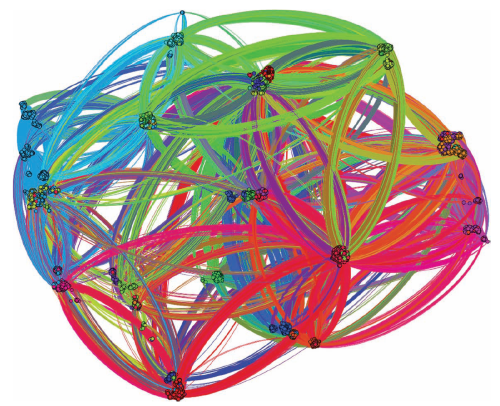Page Not Found
Page not found. Your pixels are in another canvas.
A list of all the posts and pages found on the site. For you robots out there is an XML version available for digesting as well.
Page not found. Your pixels are in another canvas.
This is a page not in th emain menu
Published:
We need a system of new statistics, e.g., A New View of Statistics.
Published:
Mark with a picture, taking 15 years back to the place where I was educated.
Published:
To be memorized, today is the first day we come back to the normal life. It means the situation of CoVID-19 off to the safe level in Beijing.
This is an amazing picture I took when I visited Zhangye in 2019.
This is a render I made when I established the high-resolution connectome of the human brain in 2011.
Published in Cerebral Cortex, 2012
This work assembles and visualizes the voxel-wise (4 mm) functional connectome as a functional network.
Recommended citation: Xi-Nian, Zuo; Ross, Ehmke; Maarten, Mennes; Davide, Imperati; F Xavier, Castellanos; Olaf, Sporns; Michael P, Milham. (2012). "Network centrality in the human functional connectome." Cerebral Cortex. 22(8):1862–1875. https://academic.oup.com/cercor/article-pdf/22/8/1862/17306507/bhr269.pdf
Published in Scientific Data, 2014
The Consortium for Reliability and Reproducibility (CoRR) is working to address this challenge and establish test-retest reliability as a minimum standard for methods development in functional connectomics.
Recommended citation: Xi-Nian, Zuo; Jeffrey S., Anderson; Pierre, Bellec; Rasmus M., Birn; Bharat B., Biswal; Janusch, Blautzik; et al. (2014). "An open science resource for establishing reliability and reproducibility in functional connectomics." Scientific Data. 1:140049. https://pubmed.ncbi.nlm.nih.gov/25977800
Published in Science Bulletin, 2015
This paper introduces a computational pipeline—namely the Connectome Computation System (CCS).
Recommended citation: Ting, Xu; Zhi, Yang; Lili, Jiang; Xiu-Xia, Xing; Xi-Nian, Zuo. (2015). "A Connectome Computation System for discovery science of brain." Science Bulletin. 60(1):86-95. https://github.com/zuoxinian/CCS/blob/master/manual/ccs.paper.pdf
Published in Cerebral Cortex, 2016
This work provides network-specific hypotheses for discovery of the specific genetic and environmental factors influencing functional specialization and integration of the human brain.
Recommended citation: Zhi, Yang; Xi-Nian, Zuo; Katie L, McMahon; R Cameron, Craddock; Clare, Kelly; Greig I, de Zubicaray; Ian, Hickie; Peter A, Bandettini; F Xavier, Castellanos; Michael P, Milham; Margaret J, Wright. (2016). "Genetic and environmental contributions to functional connectivity architecture of the human brain." Cerebral Cortex, 26(5):2341-2352. https://academic.oup.com/cercor/article/26/5/2341/1754303
Published in Human Brain Mapping, 2016
This paper elucidates the relationship between anxiety and amygdala iFC with common cortical networks.
Recommended citation: Ye, He; Ting, Xu; Wei Zhang; Xi-Nian, Zuo. (2016). "Lifespan anxiety is reflected in human amygdala cortical connectivity." Human Brain Mapping. 37(3):1178-1193. https://pubmed.ncbi.nlm.nih.gov/26859312
Published in The Neuroscientist, 2016
This review proposes local functional homogeneity as a network centrality to characterize multimodal local features of the brain connectome, and render a neurobiological perspective on local functional homogeneity by linking its temporal, spatial, and individual variability to information processing, anatomical morphology, and brain development.
Recommended citation: Lili, Jiang; Xi-Nian, Zuo. (2016). Regional Homogeneity: A multimodal, multiscale neuroimaging marker of the human connectome. The Neuroscientist, 22(5):486-505. https://journals.sagepub.com/doi/10.1177/1073858415595004
Published in Trends in Cognitive Sciences, 2017
This paper surveys empirical findings in life-span connectomics.
Recommended citation: Xi-Nian, Zuo; Ye, He; Richard F., Betzel; Stan, Colcombe; Olaf, Sporns; Michael P., Milham. (2017). "Human connectomics across the life span." Trends in Cognitive Sciences. 21(1):32-45. http://zuoxinian.github.io/files/TiCS2017.pdf
Published in Science Bulletin, 2018
This paper proposes a new field, developmental population neuroscience (DPN), for identifying environmental and genetic factors that shape development of the human brain.
Recommended citation: Xi-Nian, Zuo; Ye, He; Xuequan, Su; Xiao-Hui, Hou; Xuchu, Weng; Qiang, Li. (2018). "Developmental population neuroscience: emerging from ICHBD." Science Bulletin, 63(6):331-332. https://www.sciencedirect.com/science/article/pii/S2095927318300082
Published in Nature Human Behaviour, 2019
This comment focuses on reliability in neuroimaging and provides examples of how the reliability can be increased.
Recommended citation: Xi-Nian, Zuo; Ting, Xu; Michael P., Milham. (2019). "Harnessing reliability for neuroscience research." Nature Human Behaviour, 3:768–771. https://rdcu.be/bH2iL
Published in Science Bulletin, 2020
In this work, the researchers analyzed a large neuroimaging dataset of Chinese and American pediatric brains, and demonstrated that age- and ethnicity-specific brain templates enable more reliable and accurate mapping of human brain growth charts.
Recommended citation: Hao-Ming, Dong; F. Xavier, Castellanos; Ning, Yang; Zhe, Zhang; Quan, Zhou; Ye, He; Lei, Zhang; Ting, Xu; Avram J., Holmes; B.T.Thomas, Yeo; Feiyan, Chen; Bin, Wang; Christian, Beckmann; Tonya, White; Olaf, Sporns; Jiang, Qiu; Tingyong; Feng; Antao, Chen; Xun, Liu; Xu, Chen; Xuchu, Weng; Michael P., Milham; Xi-Nian, Zuo. (2020). "Charting brain growth in tandem with brain templates at school age." Science Bulletin, 65(22):1824-1834. https://www.sciencedirect.com/science/article/pii/S2095927320304965
Published in PNAS, 2021
Here, we describe age-dependent shifts in the macroscale organization of cortex in childhood and adolescence. The characterization of functional connectivity patterns in children revealed an overarching organizational framework anchored within the unimodal cortex, between somatosensory/motor and visual regions. Conversely, in adolescents, we observed a transition into an adult-like gradient, situating the default network at the opposite end of a spectrum from primary somatosensory/motor regions.
Recommended citation: Hao-Ming, Dong; Daniel S., Margulies; Xi-Nian, Zuo; Avram J., Holmes. (2021). "Shifting gradients of macroscale cortical organization mark the transition from childhood to adolescence." Proceedings of the National Academy of Sciences USA, 118(28):e2024448118. https://www.pnas.org/content/118/28/e2024448118
Published in DCN, 2021
The ongoing Chinese Color Nest Project (CCNP) was established to create normative charts for brain structure and function across the human lifespan, and link age-related changes in brain imaging measures to psychological assessments of behavior, cognition, and emotion using an accelerated longitudinal design. In the initial stage, CCNP aims to recruit 1520 healthy individuals (6–90 years), which comprises three phases: developing (devCCNP: 6–18 years, N = 480), maturing (matCCNP: 20–60 years, N = 560) and aging (ageCCNP: 60–84 years, N = 480). In this paper, we present an overview of the devCCNP, including study design, participants, data collection and preliminary findings.
Recommended citation: Siman, Liu; Yin-Shan, Wang; Qing, Zhang; Quan, Zhou; Li-Zhi, Cao; Chao, Jiang; Zhe, Zhang; Ning, Yang; Qi, Dong; Xi-Nian, Zuo; The Chinese Color Nest Consortium. (2021). "Chinese Color Nest Project: An accelerated longitudinal brain-mind cohort." Developmental Cognitive Neuroscience, 52:101020. https://www.sciencedirect.com/science/article/pii/S1878929321001109?via%3Dihub
Published in PSYCHRAD, 2021
We review the relationship between mental disorders and atypical brain development from a perspective of normative brain development by surveying the recent progress in the development of brain growth charts, including four aspects on growth chart utility: 1) cohorts, 2) measures, 3) mechanisms, and 4) clinical translations. In doing so, we seek to clarify the challenges and opportunities in charting brain growth, and to promote the application of brain growth charts in clinical practice.
Recommended citation: Li-Zhen, Chen; Avram J, Holmes; Xi-Nian, Zuo; Qi, Dong. (2021). "Neuroimaging brain growth charts: A road to mental health." Psychoradiology, 1(4):272-286. https://academic.oup.com/psyrad/article/1/4/272/6490296
Published in NATURE, 2022
With the goal of basing these reference charts on the largest and most inclusive dataset available, acknowledging limitations due to known biases of MRI studies relative to the diversity of the global population, we aggregated 123,984 MRI scans, across more than 100 primary studies, from 101,457 human participants between 115 days post-conception to 100 years of age.
Recommended citation: R. A. I. Bethlehem; J. Seidlitz; S. R. White; et al. (2022). "Brain charts for the human lifespan." Nature, 604(7906):525-533. https://www.nature.com/articles/s41586-022-04554-y
Published in ARXIV, 2022
A recent editorial in Nature noted that cognitive neuroscience is at a crossroads where it is a thorny issue to reliably reveal brain-behavior associations. This commentary sketches a big data science way out for cognitive neuroscience, namely population neuroscience. In terms of design, analysis, and interpretations, population neuroscience research takes the design control to an unprecedented level, greatly expands the dimensions of the data analysis space, and paves a paradigm shift for exploring mechanisms on brain-behavior associations.
Recommended citation: Z. X. Zhou & X. N. Zuo. (2022). "A paradigm shift in neuroscience driven by big data: State of art, challenges, and proof of concept." arXiv, arXiv:2212.04195. https://arxiv.org/abs/2212.04195
Published in SCIBULL, 2023
It is of great scientific and translational promise to formulate a normative reference for the lifespan development of human brain to precisely quantify individual differences. By aggregating more than 120,000 brain imaging scans across the world, the Lifespan Brain Chart Consortium (LBCC) recently published brain charts for the human lifespan in Nature. These charts have revealed previously undocumented neurodevelopmental milestones, marking a research model on team working for the neuroimaging community towards population neuroscience. The LBCC team demonstrated that after decades of advancement and accumulation in technologies, methods, and resources, we now have a tangible opportunity to achieve translational science for brain health.
Recommended citation: Z. X. Zhou, L. Z. Chen, M. P. Milham, X. N. Zuo & Lifespan Brain Chart Consortium. (2023). "Six cornerstones for translational brain charts." Science Bulletin, 68:795-799. https://doi.org/10.1016/j.scib.2023.03.047
Published in NETWORK NEUROSCI, 2023
It is an essential mission for neuroscience to understand the individual differences in brain function. Graph or network theory offer novel methods of network neuroscience to address such a challenge. This article documents optimal strategies on the test-retest reliability of measuring individual differences in intrinsic brain networks of spontaneous activity. The analytical pipelines are identified to optimize for highly reliable, individualized network measurements. These pipelines optimize network metrics for high interindividual variances and low inner-individual variances by defining network nodes with whole-brain parcellations, deriving the connectivity with spontaneous high-frequency slow-band oscillations, constructing brain graphs with topology-based methods for edge filtering, and favoring multilevel or multimodal metrics. These psychometric findings are critical for translating the functional network neuroscience into clinical or other personalized practices requiring neuroimaging markers.
Recommended citation: C. Jiang, Y. He, R. F. Betzel, Y. S. Wang, X. X. Xing & X. N. Zuo. (2023). "Optimizing network neuroscience computation of individual differences in human spontaneous brain activity for test-retest reliability." Network Neuroscience, 7:1080–1108. https://doi.org/10.1162/netn_a_00315
Published:
This talk gives a comprehensive description of the Chinese Color Nest Project.
Published:
This talk covers measurement theory and its importance for big data research in neuroimaging field.
Published:
This gives birth of a new field, namely Developmental Population Neuroscience (DPN), which will be introduced by the present keynote. The speaker will survey and foresee DPN progresses by presenting the most established and recognized scientific findings during the past two decades as well as connecting it with the national brain project.
Published:
Neuroscientists are working to rapidly amass the large-scale sample sizes needed to meaningfully study individual differences and support reproducible biomarker discovery (e.g., big cohorts). Although promising, the measurement reliability of individual samples is often suboptimal, thereby requiring unnecessarily large sample sizes to achieve the same goals. Functional neuroimaging provides an example, as recent works suggest that data acquisitions may need to be made longer to achieve desired levels of reliability. The implications of the present talk extend to the broader life sciences. Visit the seminar website for more details.
Published:
This talk will present the work generating age-normed brain templates for children and adolescents at one-year intervals and the corresponding growth charts. Age- and ethnicity-specific brain templates facilitate establishing unbiased pediatric brain growth charts, indicating the necessity of the brain charts and brain templates generated in tandem.
Published:
In this talk, I will introduce a new statistical framework on reliability and validity of measuring the individual differences. Within this framework, the relationship among reliability, effect size, sample size was simulated under a given statistical power.
Published:
This is a comprehensive introduction of the new direction - developmental population neuroscience. Visit the conference website for more details. A special issue on this conference has been published in Brain Imaging and Behavior.
Published:
This is a comprehensive introduction of the open neuroimaging resource in China. Visit the conference website for more details. The recorded video of my presentation is accessible at youtube.
Education Course, Annual Meeting of the Organization on Human Brain Mapping (OHBM), 2018
This is a series of education courses I taught during OHBM conferences (2018 - 2020).
Undergraduate course, Beijing Normal University, Faculty of Psychology, 2021
This is a description of a teaching experience on Developmental Population Neuroscience.
Undergraduate Course, Beijing Normal University, Faculty of Psychology, 2022
Developmental Population Neuroscience